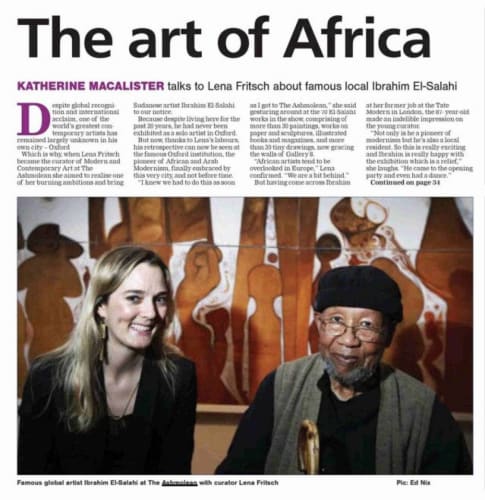Despite global recognition and international acclaim, one of the world's greatest contemporary artists has remained largely unknown in his own city - Oxford. Which is why, when Lena Fritsch became the curator of Modern and Contemporary Art at The Ashmolean she aimed to realise one of her burning ambitions and bring Sudanese artist Ibrahim El-Salahi to our notice. Because despite living here for the past 30 years, he had never been exhibited as a solo artist in Oxford. But now, thanks to Lena's labours, his retrospective can now be seen at the famous Oxford institution, the pioneer of African and Arab modernism, finally embraced by this very city, and not before time.
'I knew we had to do this as soon as soon as i got to the Ashmolean', she said gesturing around at the 70 El-Salahi works in the show, comprising of more than 30 paintings, works on paper and sculptures, illustrated books and magazines, and more than 30 tiny drawings, now gracing the walls of Gallery 8.
'African artists tend to be overlooked in Europe', Lena confirmed. 'We are a bit behind'.
But having come across Ibrahim at her former job at the Tate Modern in London, the 87 year old made an indelible impression on the young curator.
'Not only is he a pioneer of modernism but hes also a local resident. So this is really exciting and Ibrahim is really happy with the exhibition which is a relief', she laughs. 'He came to the opening party and even had a dance'.
As a result, Lena is now an expert on Ibrahim and his fascinating life.
Born in Sudan's second largest city Khartoum in 1930, he enrolled at the design school there before taking up a place at the Slade School of Art in London, spending his days at The British Museum and soaking up all the capital's culture. In 1957, he was excited to showcase his influences and his resulting art back home in Sudan, but his modernist show was misunderstood and his triumphant exhibition flopped. He was ahead of his time it seemed.
'They weren't interested', Lena says sadly. 'Or perhaps they didn't understand the mix of caligraphy, Islamic influences and African abstraction in his painting which he hoped the Sudanese people would relate to.'
'Because you can't escape from the African heat and deserts of Sudan in his work, or the western influences which give it a more contemporary feel.'
Disillusioned Ibrahim travelled to new York but couldn't survive as an artist there so worked in various diplomatic and cultural posts, landing back in London as the cultural attache for the Sudanese Embassy.
Asked to return to Sudan in the 1970s as director of culture. Ibrahim knew it was a risky posting, the political dictatorship of the time meaning art could certainly be seen as anarchic. In 1975, he was arrested and imprisoned for more than 6 months. Yet despite a lack of any artistic paraphernalia, he continued to draw on scraps of paper and in the sand of his cell in the notorious Kober prison.
On being released, and after a stint in Qatar, Ibrahim then made his home in East Oxford with his wife and children, painting in a studio at the end of his garden from memory, revisiting certain themes continually.
For example, his Tree series, links heaven and earth as well as representing the survival and resilience of the Sudanese people. A more meditative theme then creeps into his later work.
Yet despite his international recognition, plaudits and recognition, his adopted country was remarkably untouched by the noble and ground-breaking artist living in their midst.
And then came the Tate Modern exhibition which changed everything. Entitled A Visionary Modernist, it was dedicated to African Modernism and traced Ibrahim's life and work in a major retrospective by bringing together 100 works from across five decades oh his international career.
'This exhibition highlights one of the most significant figures in African and Arab Modernism and reveals his place in the context of a broader, global art history', the brochures boasted.
Yet in Oxford, still nothing, until Lena came along.
'I wanted to introduce him to the people of Oxford and to reproduce what he had achieved at Tate Modern, while structuring it differently to include a nice mix of his most famous works', she says.
Hence you can explore early beginnings right through to his twilight years, gathered from private collection and galleries around the world, as well as Ibrahim's own hoard and illustrated diaries.
Intertwining Ibrahim's body of work with The Ashmolean's archaeological collections from Ancient Sudan, Lena provides both a context, visual identity and a poignant reminder of Ibrahim's homeland.
'His work relates to his people, their motifs traditions and political situation', Lena says. 'He never left the colour, sounds and heat of Africa behind. And although his is frail he can still draw. It's his life. So this has all bee worth it. He is a very wise man', she smiles.

